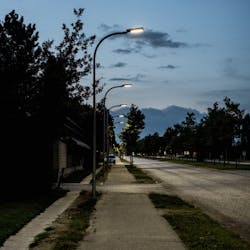1. “Conventional wisdom” about outdoor illumination and visibility is misleading.
Parks tackled the correlated color temperature (CCT) controversy head-on…without discounting the perception of light as it plays into the mix. He stated unequivocally that there are studies demonstrating no visibility improvement over ~3500K CCT. It has long been assumed that any CCT higher than this will make areas more visible, but Parks cited 2012 findings from the Virginia Tech Transportation Institute (VTTI) that determined 3500K delivered plenty of visibility and appropriate contrast of objects for drivers, which chief editor Maury Wright has written about. (You can access the VTTI study on ResearchGate.)
2. LED lighting requires a more thoughtful approach than just one-for-one replacement of fixtures.
Parks explained that the common tactic to lighting retrofits is just not going to cut it in outdoor public spaces. Using BUG (backlight, uplight, glare) ratings to guide fixture selection, along with IES RP-8 minimum luminance recommendations, will help prevent overlighting that results from simply replacing each existing high-pressure sodium (HPS) fixture. Minimizing wasted light that generates glare for both pedestrians and drivers should be a higher design priority. More on that later.
3. There is an institutional resistance to change.
It’s natural to have reservations about what we don’t understand, especially when municipal planners are concerned with long-term impact and costs. After all, they have a fiscal responsibility to the community as well as a commitment to public safety. “[LED technology] scares the bejeezus out of a lot of them,” said Parks. But a pledge to replace conventional lighting with more energy-efficient SSL is a good one — if it is done carefully, controls will increase the savings over time and reduce the amount of glare and wasted lumens. This reticence is why municipal authorities should seek out experts in outdoor lighting design who are aware of the priorities and how to balance cost, quality of light, and security with environmental impacts like sky glow and wildlife disruption.
4. Conflicting priorities can blind you to appropriate design.
Take the conflict out of it with a careful design plan — that’s what I got. Get strategic about the retrofit locations and their main purpose. City planners and authorities can get caught in the trap of assuming the brightest light output for the cheapest price is the best way to go, when in fact they could save a lot more energy — and thus money — by evaluating spaces and planning for controls that will dim and brighten lights as needed, and putting the right kind of fixtures in the proper locations and at heights that enhance pedestrian safety and driver visibility.
5. Community perception and involvement needs to change.
I smiled when Parks talked about piloting LED lighting installations and surveying the community because I wrote about that on a recent blog. Community outreach and perception will have an impact on the budgeting and execution of city engineering projects. Involving the public will help to eliminate the regrets that may come when everyone is knocking on your door complaining about the obnoxious light streaming into their neighborhoods.
View the full on-demand webcast and I promise you’ll get much more out of it, such as details on luminance and chrominance contrast, uniformity, how to use standards and recommendations for today’s lighting needs, and so on. You can also visit http://volt.org/ to get more information on the Community Friendly Lighting program from SOLA.






